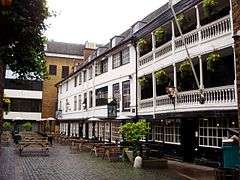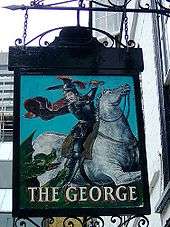The George Inn, Southwark
The George or George Inn is a public house established in the medieval period on Borough High Street in Southwark, London, owned and leased by the National Trust. It is located about 250 metres (820 ft) from the south side of the River Thames near London Bridge and is the only surviving galleried London coaching inn.[1]
| The George Inn | |
|---|---|
 | |

| |
| Former names |
|
| Alternative names | The George |
| General information | |
| Type | Public house |
| Address | Borough High Street London, SE1 United Kingdom |
| Coordinates | 51.504182°N 0.090021°W |
| Current tenants | Tenanted by brewery |
| Owner | National Trust |
| Technical details | |
| Structural system | partly timber framed |
| Website | |
| www | |
History
The first map of Southwark (Duchy of Lancaster ca1543) clearly shows it marked as 'Gorge'. It was formerly known as the George and Dragon, named after the legend of Saint George and the Dragon. There were many such inns in this part of London. Probably the most famous was The Tabard where, in 1388, Chaucer began The Canterbury Tales. In 1677 the George was rebuilt after a serious fire that destroyed most of medieval Southwark.[2] The Tabard was also rebuilt after the same fire, but was demolished in the late nineteenth century.
It is known that galleried inns were used for Elizabethan theatrical productions (Inn-yard theatre).
Later, the Great Northern Railway used the George as a depot and pulled down two of its fronts to build warehousing. Now just the south face remains.
The George was one of the many famous coaching inns in the days of Charles Dickens. Dickens in fact visited the George and referred to it in Little Dorrit.
Description
The building is partly timber framed.[3] The ground floor is divided into a number of connected bars. The Parliament Bar used to be a waiting room for passengers on coaches. The Middle Bar was the Coffee Room, which was frequented by Charles Dickens. The bedrooms, now a restaurant, were upstairs in the galleried part of the building.
It is one of only two coaching inns to survive in Greater London, and is the only galleried example. The White Hart is immediately to the north, and the site of The Tabard immediately to the south (now Talbot Yard). The building is listed Grade I on the National Heritage List for England, and is listed in CAMRA's National Inventory of Historic Pub Interiors.[4]
Literature
The beer writer Pete Brown explores the history of the pub in his book Shakespeare's Local, providing information about the pub and the surrounding area.
Gallery
 The sign depicts Saint George slaying a dragon.
The sign depicts Saint George slaying a dragon. Secondary sign, with another depiction of Saint George slaying the dragon.
Secondary sign, with another depiction of Saint George slaying the dragon.
 Inn, 1858
Inn, 1858.jpg) Inn, 1889
Inn, 1889.jpg) rear of Inn and coach yard, 1889
rear of Inn and coach yard, 1889.jpg) tap room
tap room.jpg) coffee-room
coffee-room.jpg) first floor gallery
first floor gallery.jpg) bar parlour
bar parlour.jpg) dining room
dining room
References
- "George Inn". Archived from the original on 24 September 2014. Retrieved 6 December 2016.
- https://www.hudson.org/research/9610-tales-from-a-london-barstool-a-review-of-pete-brown-s-shakespeare-s-pub-
- Historic England, "The George Inn (1378357)", National Heritage List for England, retrieved 2 March 2020
- Brandwood & Jephcote, Geoff & Jane (July 2008). London Heritage Pubs – An Inside Story. CAMRA (Campaign For Real Ale) Books. ISBN 978-1-85249-247-2.
Further reading
- Matz, Bertram Waldrom (1918). . London: Chapman and Hall.
- Brown, Pete (2012). Shakespeare's Local. London: Pan Books.